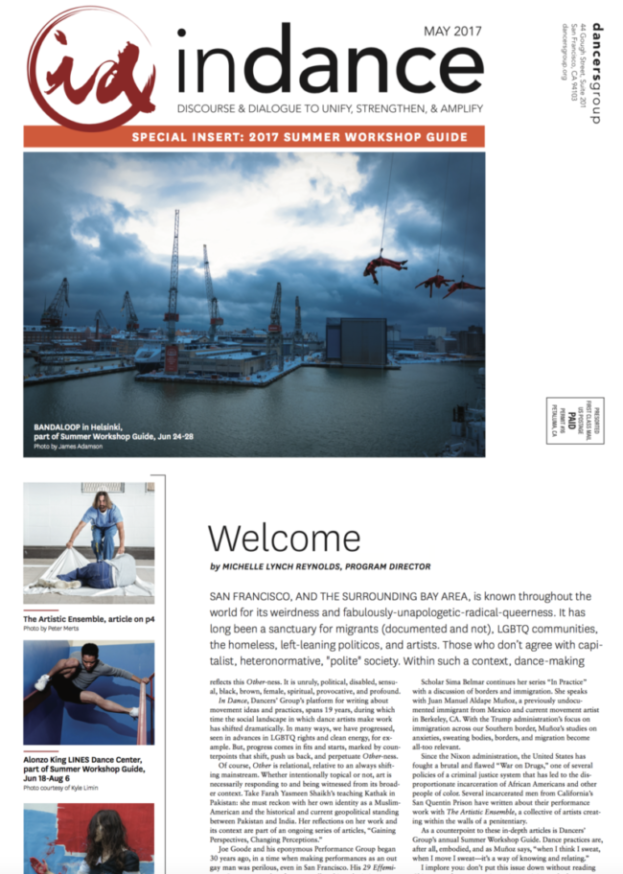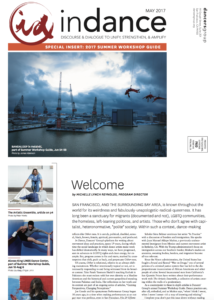
 San Francisco, and the surrounding Bay Area, is known throughout the world for its weirdness and fabulously-unapologetic-radical-queerness. It has long been a sanctuary for migrants (documented and not), LGBTQ communities, the homeless, left-leaning politicos, and artists. Those who don’t agree with capitalist, heteronormative, “polite” society. Within such a context, dance-making reflects this Other-ness. It is unruly, political, disabled, sensual, black, brown, female, spiritual, provocative, and profound.
San Francisco, and the surrounding Bay Area, is known throughout the world for its weirdness and fabulously-unapologetic-radical-queerness. It has long been a sanctuary for migrants (documented and not), LGBTQ communities, the homeless, left-leaning politicos, and artists. Those who don’t agree with capitalist, heteronormative, “polite” society. Within such a context, dance-making reflects this Other-ness. It is unruly, political, disabled, sensual, black, brown, female, spiritual, provocative, and profound.
In Dance, Dancers’ Group’s platform for writing about movement ideas and practices, spans 19 years, during which time the social landscape in which dance artists make work has shifted dramatically. In many ways, we have progressed, seen in advances in LGBTQ rights and clean energy, for ex- ample. But, progress comes in fits and starts, marked by counterpoints that shift, push us back, and perpetuate Other-ness.
Of course, Other is relational, relative to an always shifting mainstream. Whether intentionally topical or not, art is necessarily responding to and being witnessed from its broader context. Take Farah Yasmeen Shaikh’s teaching Kathak in Pakistan: she must reckon with her own identity as a Muslim-American and the historical and current geopolitical standing between Pakistan and India. Her reflections on her work and its context are part of an ongoing series of articles, “Gaining Perspectives, Changing Perceptions.”
Joe Goode and his eponymous Performance Group began 30 years ago, in a time when making performances as an out gay man was perilous, even in San Francisco. His 29 Effeminate Gestures was therefore groundbreaking, depicting a man embracing his femininity while wielding a chainsaw. Decades later, Goode continues to shine a light on the nuances of relationship and the politics of the intimate, all in his playful yet potent, allegorical style. Writer Kate Mattingly covers Goode’s upcoming 30th anniversary season.
Scholar Sima Belmar continues her series “In Practice” with a discussion of borders and immigration. She speaks with Juan Manuel Aldape Mun?oz, a previously undocumented immigrant from Mexico and current movement artist in Berkeley, CA. With the Trump administration’s focus on immigration across our Southern border, Mun?oz’s studies on anxieties, sweating bodies, borders, and migration become all-too relevant.
Since the Nixon administration, the United States has fought a brutal and flawed “War on Drugs,” one of several policies of a criminal justice system that has led to the disproportionate incarceration of African Americans and other people of color. Several incarcerated men from California’s San Quentin Prison have written about their performance work with The Artistic Ensemble, a collective of artists creating within the walls of a penitentiary.
As a counterpoint to these in-depth articles is Dancers’ Group’s annual Summer Workshop Guide. Dance practices are, after all, embodied, and as Mun?oz says, “when I think I sweat, when I move I sweat—it’s a way of knowing and relating.”
I implore you: don’t put this issue down without reading Chicano performance artist, writer, activist, and educator Guillermo Go?mez-Pen?a’s Letter to the Revolution. I carry his words with me in this unpredictable time when society seems to be heading backward towards Other-ing: “We continue to talk back & make art.”


